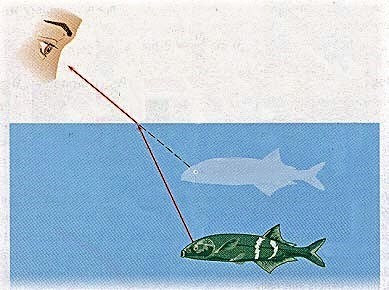
Not every student will grow up and study physics on a deeper level, but physics extends well into our daily life, describing the motion, forces and energy of ordinary experience. Therefore, it should be possible to illustrate to anyone the physics of everyday life, with examples of course.
Image formation
Have you noticed that when standing inside a room at night, you can often see your reflection in a pane of glass? In similar way, because there is much less light coming from the bottom of a lake, the surface of the lake will act like a mirror.

But an image can also be formed by refraction. A fish seen in the water will usually appear to be at a different depth than it actually is, due to the refraction of light rays as they travel from the water into the air.

Lastly, there exist phenomena which appear due to combination of reflection and refraction. For example, a rainbow is seen when light passes through water droplets hanging in the atmosphere. The light bends, or refracts, as it enters the droplet, and then reflects off the inside of the raindrop.

Washing machine
The dryer of washing machine is a rapidly rotating container that applies centrifugal force to its contents. The centrifugal force acts in a direction away from the centre and hence can be used to throw the water molecules on the clothes radially outwards during the spin cycle of the washing machine.
Static electricity
When two objects that are not good electrical conductors are rubbed together, electrons from one of the objects rub off onto the other.

The more rubbing between two objects, the more static electricity build up and the larger the electrical charge.
Road safety
When brakes are applied to a moving car, the car and lower portions of the passengers attached to the car come to immediate stop, but their upper portions fall forwards, because of inertia. This is why seat belts as well as air bags are installed in the car.

Roller coaster
The first hill of the ride is always the highest one so that the car collects enough energy to go through all the elevations. As the car goes down, its potential energy decreases but kinetic energy increases. If added together at any part of the ride, the kinetic and potential energies of the car will equal the potential energy that the car had on the first hill.
Spinning
When the figure skater draws her arms and a leg inward, she reduces her moment of inertia thus rotating at a faster angular speed. This is due to conservation of angular momentum.

Handle of the door
If you apply force close to the hinge of the door, the door will not open as it will not be able to rotate about the hinge. But, when you apply the same force farther away from the hinge, the torque will be larger. Hence, the door opens easily with less effort.
Falling down
Suppose you are climbing a tree, and suddenly you slip and fall down from the tree. Then, you may break a bone or two. But if same thing happens to a little ant, that is, if it falls down from height, it does not get hurt. Why is it so?
From ant’s point of view, the atmosphere is thick and viscous and its experience of falling from a height is similar to ours when we fall through water to the bottom of the pool. The air underneath the falling ant becomes like a large cushion of safety.
Roundness
Nobel prize winning physicist Richard Feynman explains why little drops of water are round in the following video.
Sound game
When a water bottle fills up, the air column or amount of air inside the bottle decreases. As a result, the pitch (or shrillness) of the sound will increase, as it is inversely proportional to the length of vibrating air column. Therefore, you can tell exactly when the bottle is full without even looking.

Summing up
It is hard to imagine of life without physics. Even though one may not be equipped with the kind of mathematics required to fully understand these physical phenomena, one can surely appreciate the fact that they are there. Lots of other examples are available and you just need the eye to recognize them.
Image formation
Have you noticed that when standing inside a room at night, you can often see your reflection in a pane of glass? In similar way, because there is much less light coming from the bottom of a lake, the surface of the lake will act like a mirror.

But an image can also be formed by refraction. A fish seen in the water will usually appear to be at a different depth than it actually is, due to the refraction of light rays as they travel from the water into the air.

Lastly, there exist phenomena which appear due to combination of reflection and refraction. For example, a rainbow is seen when light passes through water droplets hanging in the atmosphere. The light bends, or refracts, as it enters the droplet, and then reflects off the inside of the raindrop.

Washing machine
The dryer of washing machine is a rapidly rotating container that applies centrifugal force to its contents. The centrifugal force acts in a direction away from the centre and hence can be used to throw the water molecules on the clothes radially outwards during the spin cycle of the washing machine.
Static electricity
When two objects that are not good electrical conductors are rubbed together, electrons from one of the objects rub off onto the other.

The more rubbing between two objects, the more static electricity build up and the larger the electrical charge.
Road safety
When brakes are applied to a moving car, the car and lower portions of the passengers attached to the car come to immediate stop, but their upper portions fall forwards, because of inertia. This is why seat belts as well as air bags are installed in the car.

Roller coaster
The first hill of the ride is always the highest one so that the car collects enough energy to go through all the elevations. As the car goes down, its potential energy decreases but kinetic energy increases. If added together at any part of the ride, the kinetic and potential energies of the car will equal the potential energy that the car had on the first hill.
Spinning
When the figure skater draws her arms and a leg inward, she reduces her moment of inertia thus rotating at a faster angular speed. This is due to conservation of angular momentum.

Handle of the door
If you apply force close to the hinge of the door, the door will not open as it will not be able to rotate about the hinge. But, when you apply the same force farther away from the hinge, the torque will be larger. Hence, the door opens easily with less effort.
Falling down
Suppose you are climbing a tree, and suddenly you slip and fall down from the tree. Then, you may break a bone or two. But if same thing happens to a little ant, that is, if it falls down from height, it does not get hurt. Why is it so?
From ant’s point of view, the atmosphere is thick and viscous and its experience of falling from a height is similar to ours when we fall through water to the bottom of the pool. The air underneath the falling ant becomes like a large cushion of safety.
Roundness
Nobel prize winning physicist Richard Feynman explains why little drops of water are round in the following video.
Sound game
When a water bottle fills up, the air column or amount of air inside the bottle decreases. As a result, the pitch (or shrillness) of the sound will increase, as it is inversely proportional to the length of vibrating air column. Therefore, you can tell exactly when the bottle is full without even looking.

Summing up
It is hard to imagine of life without physics. Even though one may not be equipped with the kind of mathematics required to fully understand these physical phenomena, one can surely appreciate the fact that they are there. Lots of other examples are available and you just need the eye to recognize them.















 Physics, astronomy and science history blog for students
Physics, astronomy and science history blog for students